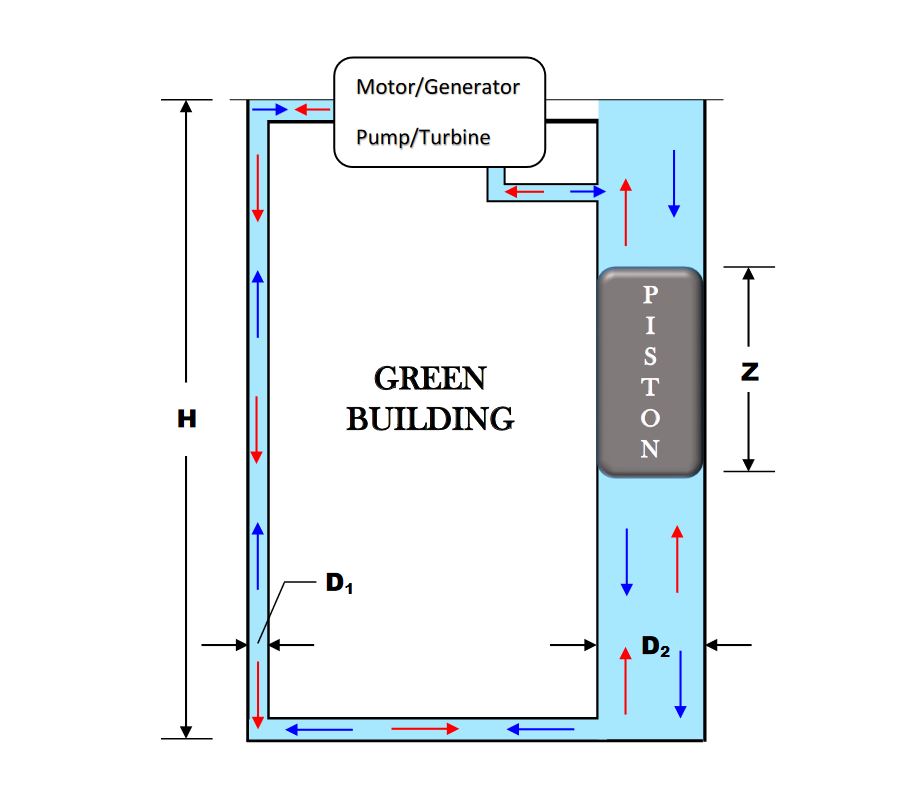Researchers from the Jadavpur University Salt Lake Campus in India have proposed a new way to combine gravity storage and redox flow batteries with PV generation in a multi-level buildings.
“Our hybrid system can be implemented in any kind of building but the energy content of the gravity storage system increases with the height of the building, which means high buildings offer the largest potential for its development,” researcher Mayurakshi Mondal told pv magazine.
The hybrid system consists of a conventional rooftop PV system, a solar tree, two gravity power modules for building (GPMBs), and a vanadium redox flow battery (VRFB), with the three storage systems being charged exclusively by the two solar installations. “The proposed system emphasizes on supplying the essential load demand of a building through renewable energy as much as possible, especially focusing on the reduction of the demand from the grid at peak hours,” the scientists explained. “The system is also focused to flatten the load demand curve of the grid.”
They estimated the levelized cost of energy (LCOE) of the redox flow battery at $0.424/kWh and that of the GPM at $0.148/kWh. Due to this difference, the battery is used only as a secondary storage system, the said. During the charging phase, the GPMBs work via a motor that drives a pump to push water from the top of a piston in a larger pipe into a smaller one. It then pushes it back to the larger pipe below the piston.
“This pushes the piston upward and the operation terminates when the piston reaches the topmost position of the larger pipe, thereby storing energy in the mechanical form,” the Indian group said, noting that both GPMBs should have a diameter of 1.5 meters each for the larger pipe.
In the discharging phase, the piston in the larger pipe comes down and pushes the water downward, into the smaller pipe. The water flows through the pump/turbine unit operating in the turbine mode and generates electricity with the electrical device operating in the generator mode, the academics said. “The discharging operation ends when the piston reaches the bottom-most point in the larger pipe.”
They considered a 110-meter building with 39 floors and a total floor area of 750 square meters. The two GPMBs have a storage capacity of 96.2 kWh each and the redox flow battery is able to store 300 kWh. The 75.4 kW PV system occupies a surface of 450 square meters, which corresponds to around 60% of the roof area, and five solar trees totaling 57.7 kW are installed in the exterior open-air space of the building.
“After meeting the residential load demand and charging both GPMBs, any extra generated energy is used to charge the VRFB. Thereafter, any remaining energy generated is sold to the grid,” they said.
In the proposed system configuration, two GPMBs only supply electricity within the peak hours 6 pm to 9 pm and 9 pm to 12 pm, in order to reduce the burden of peak hours over the grid.
“The proposed system is able to supply 47.77% of renewable energy to the building as a yearly average and is capable of injecting 48.89% renewable energy to the building along with grid,” the researchers said.
They described the hybrid system in “Solar PV driven hybrid gravity power module—Vanadium redox flow battery energy storage for an energy efficient multi-storied building,” which was recently published in the International Journal of Energy Research.
“Further studies on GPMB are required before practical implementation, like the effect of high starting current devices such as an air-conditioner, water pump and so on over its operation,” the scientists said. “The system also requires a cost optimization analysis.”
This content is protected by copyright and may not be reused. If you want to cooperate with us and would like to reuse some of our content, please contact: editors@pv-magazine.com.




There are several similar technologies to the proposed one already under development for years. Just google “Gravity Power LLC” or “Power Tower”. They usually do not make any economical sense anywhere, if you cannot reach a hight of at least 100m. In addition, the piston has to have always half the hight of the shaft to achieve the maximum results, which is not shown correctly in the drawing, because the energy is stored in the priston and not in the water. The water is just serving as the hydraulic fluid, In addition, one should not underestimate the tremendeous weight of the piston and the water in the shaft, which would make the statics of any regular high rise structure obsolete. Another unsolved problem are the seals between the piston and the shaft. This is just a hint re the substantial technological problems which need to be addressed for such a project, which might look like a great idea at first sight.
Also note that gravity storage gets about 2.5 kWh per tonne.Km. so for a height of 100m to get nearly 100kWh of storage requires a 400 tonne plunger. Concrete is about 2.5 t/m^3, so we need 160m^3. A 1.5m diameter pipe is roughly 2m^2 across, so the plunger needs to be 80m tall. To get our 100m of drop back the pipe needs to be 180m tall now. Lead is roughly 10 t/m^3 so the plunger could be only 20m tall for a 120m tall tower. I guess that’s feasible, but how much does 400t of lead cost?
If one thinks on a bit wider scale, the weight can be built with a hollow core. The core to be equivalent to the lifting capacity of the weight and use compressed air to make the weight rise again in the shaft when it is at the bottom. Thereby you get a second stroke out of the same length of pipe, not so much to generate electricity, but to get the weight to the top without using extra ekectricity to do it.
You need a lot of electricity to create enough compressed air to lift the weight/piston. In addition, to have a hollow weight defeats the purpose of the whole system, because the heavier the weight the more energy you can store in this system. Reason: The energy in this system is not stored in the water (like in a conventional Hydro Pumped Storage system) but in the heavy piston. The water is solely used as a hydraulic fluid.